美国服务贸易具体承诺减让表.1997
- 格式:pdf
- 大小:24.22 KB
- 文档页数:6
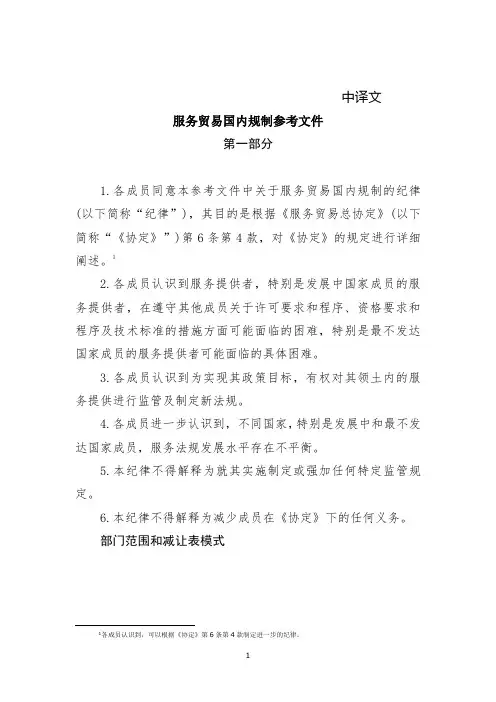
中译文服务贸易国内规制参考文件第一部分1.各成员同意本参考文件中关于服务贸易国内规制的纪律(以下简称“纪律”),其目的是根据《服务贸易总协定》(以下简称“《协定》”)第6条第4款,对《协定》的规定进行详细阐述。
12.各成员认识到服务提供者,特别是发展中国家成员的服务提供者,在遵守其他成员关于许可要求和程序、资格要求和程序及技术标准的措施方面可能面临的困难,特别是最不发达国家成员的服务提供者可能面临的具体困难。
3.各成员认识到为实现其政策目标,有权对其领土内的服务提供进行监管及制定新法规。
4.各成员进一步认识到,不同国家,特别是发展中和最不发达国家成员,服务法规发展水平存在不平衡。
5.本纪律不得解释为就其实施制定或强加任何特定监管规定。
6.本纪律不得解释为减少成员在《协定》下的任何义务。
部门范围和减让表模式1各成员认识到,可以根据《协定》第6条第4款制定进一步的纪律。
7.各成员应将第二部分纪律纳入其减让表,作为《协定》第18条下的其他承诺。
对于金融服务领域的承诺,各成员可选择纳入第三部分的替代性纪律。
8.根据本部分第7 款纳入的纪律适用于已作出的具体承诺。
此外,鼓励各成员在其减让表中列入适用本纪律的其他部门。
9.对于根据本部分第7款纳入的其他承诺,各成员可不适用第二部分第22款(d)项和第三部分第19款(d)项所列纪律。
发展发展中国家成员过渡期10.一发展中国家成员可以在本纪律生效后不超过7年的过渡期之后,就执行具体纪律指定一日期。
指定的范围可限于个别服务部门或分部门。
过渡期应列入其各自的具体承诺减让表。
一发展中国家成员如需延长执行过渡期,应按有关程序提出申请。
2各成员应考虑提出请求成员的具体情况,对批准该请求予以同情考虑。
最不发达国家成员的参与11.在脱离最不发达国家地位前6个月内,最不发达国家成员应将本部分第7 款纪律纳入其具体承诺减让表。
届时,最不发达国家成员可根据本部分第10款规定指定过渡期。
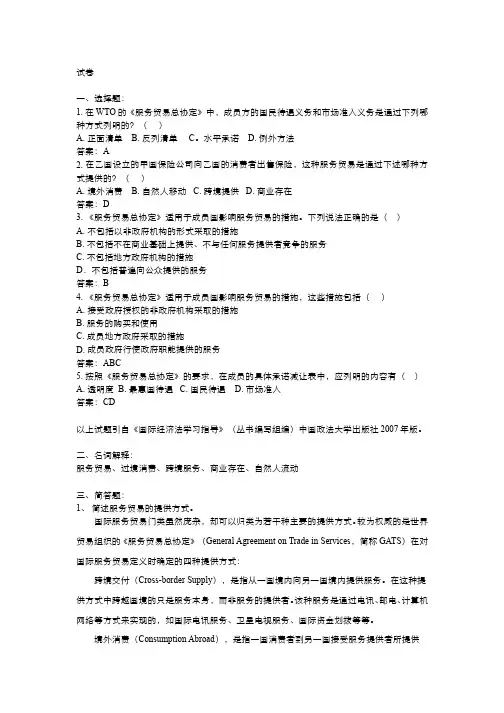
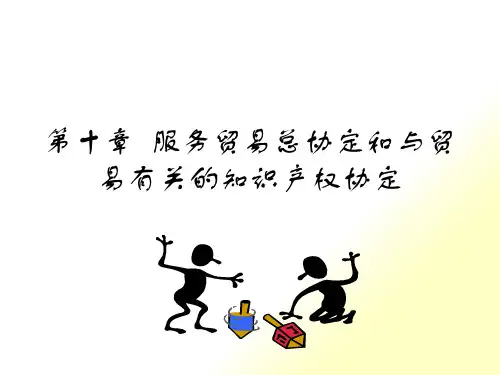
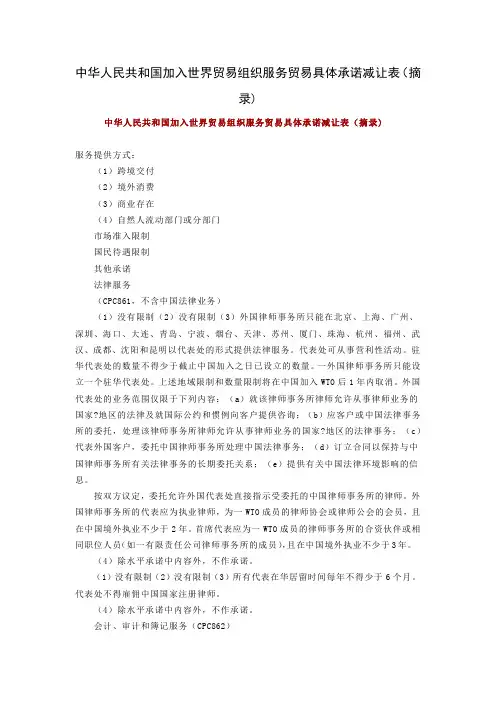
中华人民共和国加入世界贸易组织服务贸易具体承诺减让表(摘录)中华人民共和国加入世界贸易组织服务贸易具体承诺减让表(摘录)服务提供方式:(1)跨境交付(2)境外消费(3)商业存在(4)自然人流动部门或分部门市场准入限制国民待遇限制其他承诺法律服务(CPC861,不含中国法律业务)(1)没有限制(2)没有限制(3)外国律师事务所只能在北京、上海、广州、深圳、海口、大连、青岛、宁波、烟台、天津、苏州、厦门、珠海、杭州、福州、武汉、成都、沈阳和昆明以代表处的形式提供法律服务。
代表处可从事营利性活动。
驻华代表处的数量不得少于截止中国加入之日已设立的数量。
一外国律师事务所只能设立一个驻华代表处。
上述地域限制和数量限制将在中国加入WTO后1年内取消。
外国代表处的业务范围仅限于下列内容:(a)就该律师事务所律师允许从事律师业务的国家?地区的法律及就国际公约和惯例向客户提供咨询;(b)应客户或中国法律事务所的委托,处理该律师事务所律师允许从事律师业务的国家?地区的法律事务;(c)代表外国客户,委托中国律师事务所处理中国法律事务;(d)订立合同以保持与中国律师事务所有关法律事务的长期委托关系;(e)提供有关中国法律环境影响的信息。
按双方议定,委托允许外国代表处直接指示受委托的中国律师事务所的律师。
外国律师事务所的代表应为执业律师,为一WTO成员的律师协会或律师公会的会员,且在中国境外执业不少于2年。
首席代表应为一WTO成员的律师事务所的合资伙伴或相同职位人员(如一有限责任公司律师事务所的成员),且在中国境外执业不少于3年。
(4)除水平承诺中内容外,不作承诺。
(1)没有限制(2)没有限制(3)所有代表在华居留时间每年不得少于6个月。
代表处不得雇佣中国国家注册律师。
(4)除水平承诺中内容外,不作承诺。
会计、审计和簿记服务(CPC862)(1)没有限制(2)没有限制(3)合伙或有限责任会计师事务所只限于中国主管机关批准的注册会计师。
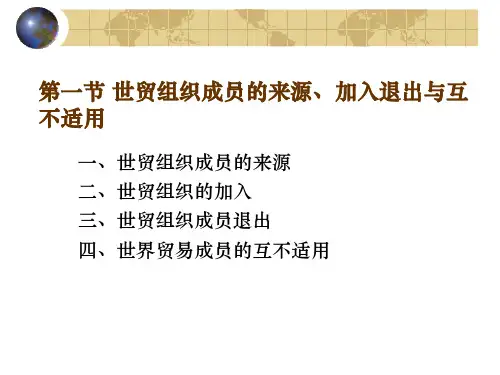

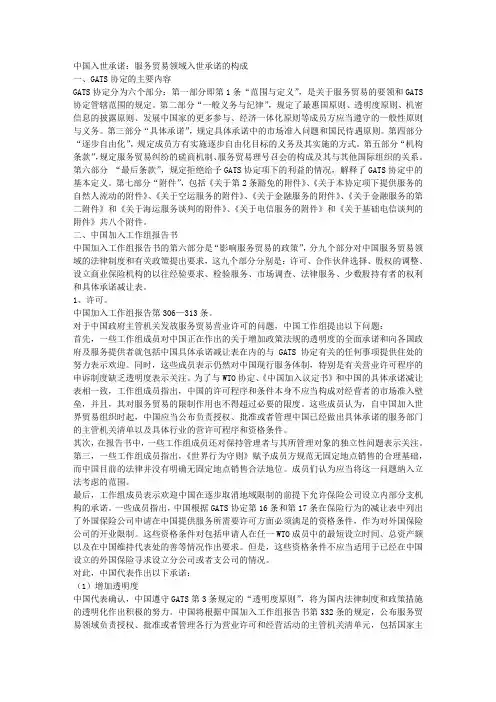
中国入世承诺:服务贸易领域入世承诺的构成一、GATS协定的主要内容GATS协定分为六个部分:第一部分即第1条“范围与定义”,是关于服务贸易的要领和GATS 协定管辖范围的规定。
第二部分“一般义务与纪律”,规定了最惠国原则、透明度原则、机密信息的披露原则、发展中国家的更多参与、经济一体化原则等成员方应当遵守的一般性原则与义务。
第三部分“具体承诺”,规定具体承诺中的市场准入问题和国民待遇原则。
第四部分“逐步自由化”,规定成员方有实施逐步自由化目标的义务及其实施的方式。
第五部分“机构条款”,规定服务贸易纠纷的磋商机制、服务贸易理号召会的构成及其与其他国际组织的关系。
第六部分“最后条款”,规定拒绝给予GATS协定项下的利益的情况,解释了GATS协定中的基本定义。
第七部分“附件”,包括《关于第2条豁免的附件》、《关于本协定项下提供服务的自然人流动的附件》、《关于空运服务的附件》、《关于金融服务的附件》、《关于金融服务的第二附件》和《关于海运服务谈判的附件》、《关于电信服务的附件》和《关于基础电信谈判的附件》共八个附件。
二、中国加入工作组报告书中国加入工作组报告书的第六部分是“影响服务贸易的政策”,分九个部分对中国服务贸易领域的法律制度和有关政策提出要求,这九个部分分别是:许可、合作伙伴选择、股权的调整、设立商业保险机构的以往经验要求、检验服务、市场调查、法律服务、少数股持有者的权利和具体承诺减让表。
1、许可。
中国加入工作组报告第306—313条。
对于中国政府主管机关发放服务贸易营业许可的问题,中国工作组提出以下问题:首先,一些工作组成员对中国正在作出的关于增加政策法规的透明度的全面承诺和向各国政府及服务提供者就包括中国具体承诺减让表在内的与GATS协定有关的任何事项提供住处的努力表示欢迎。
同时,这些成员表示仍然对中国现行服务体制,特别是有关营业许可程序的申诉制度缺乏透明度表示关注。
为了与WTO协定、《中国加入议定书》和中国的具体承诺减让表相一致,工作组成员指出,中国的许可程序和条件本身不应当构成对经营者的市场准入壁垒,并且,其对服务贸易的限制作用也不得超过必要的限度。
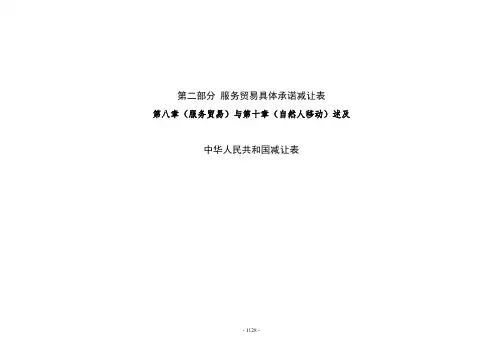
第二部分服务贸易具体承诺减让表第八章(服务贸易)与第十章(自然人移动)述及中华人民共和国减让表1如已就设立“外商独资企业”作出承诺,则也允许设立外资拥有多数股权或少数股权的合资企业,中国法律、法规另有特别要求的除外。
2就本减让表而言,对于以公司、企业、商行或者其他任何的商业存在形式参与中国市场的“外资”或“澳大利亚”服务提供者(无论是外商独资、外资拥有多数股权、外商投资、外资所有权、外资参股还是中国法律规定的其他任何外资参与形式),涉及外资或澳大利亚参与的限制或承诺,是指非中国资本的参与总额,不论其来源及所有者,包括但不限于澳大利亚的服务提供者。
外资参与的上述类型,不论集体地或者单独地都不得超过中国加入世界贸易组织时作出的承诺,符合中国现行法律、法规和规章的中国—澳大利亚自由贸易协定中更优惠的承诺除外。
3依照中国法律、法规及其他措施订立的设立“契约式合资企业”的合同条款,规定诸如该合资企业经营方式和管理方式以及合资方的投资或其他参与方式等事项。
契约式合资企业的参与方式根据合资企业的合同决定,并不要求所有参与方均进行资金投入。
本减让表中的“外商投资企业”指根据《中外合资经营企业法》、《中外合作经营企业法》、《外资企业法》合法设立或组织的外商投资企业。
4“商务访问者”是指:(a)作为自然人的服务销售人员,其是澳大利亚服务提供者的销售代表,寻求临时进入中国境内,旨在代表该服务提供者进行服务销售谈判,该代表不涉及向公众直接销售或直接提供服务;或(b)澳大利亚投资者或澳大利亚投资者的适当授权代表,寻求临时进入中国境内设立、扩大、监督和处置该投资者的商业存在。
5“经理”是指一组织内部的自然人,主要负责该组织、部门或分部门的管理,监督和控制其他负责监管、业务或管理的雇员的工作,有权雇佣、解雇或行使其他人事职能(例如提升或休假批准),在日常经营中行使决策权。
6“高级管理人员”是指一组织内部的自然人,主要负责该组织的管理,广泛行使决策权,仅接受更高管理层、董事会或企业股东的总体监督和指导。
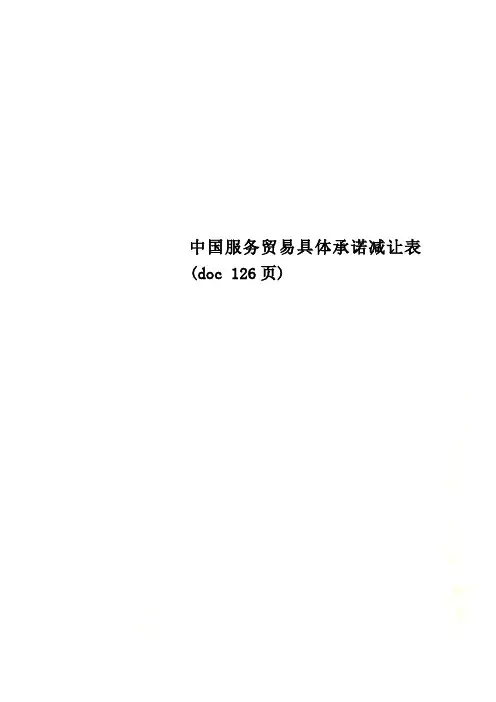
中国服务贸易具体承诺减让表(doc 126页)附件9中华人民共和国服务贸易具体承诺减让表第2条最惠国豁免清单本减让表仅以英文为准服务提供方式:(1)跨境交付(2)境外消费(3)商业存在(4)自然人流动市场准入限制国民待遇限制其他承诺部门或分部门一、水平承诺本减让表中包括的所有部门(3)在中国,外商投资企业包括外资企业(也称为外商独资企业)和合资企业,合资企业有两种类型:股权式合资企业和契约式合资企业。
①股权式合资企业中的外资比例不得少于该合资企业注册资本的25%。
由于关于外国企业分支机构的法律和法规正在制定中,因此对于外国企业在中国设立分支机构不作承诺,除非在具体分部门中另有标明。
(3)对于给予视听服务、空运服务和医疗服务部门中的国内服务提供者的所有现有补贴不作承诺。
允许在中国设立外国企业的代表外,但代表处不得从事任何营利性活动,在CPC861、862、863、865下部门具体承诺中的代表处除外。
①依照中国法律、法规及其他措施订立的设立“契约式合资企业”的合同条款,规定诸如该合资企业经营方式和管理方式以及合资方的投资或其他参与方式等事项。
契约式合资企业的参与方式根据合资企业的合同决定,并不要求所有参与方均进行资金投入。
服务提供方式:(1)跨境交付(2)境外消费(3)商业存在(4)自然人流动部门或分部门市场准入限制国民待遇限制其他承诺对于各合同协议或股权协议,或设立或批准现有外国服务提供者从事经营或提供服务的许可中所列所有权、经营和活动范围的条件,将不会使之比中国加入WTO之日时更具限制性。
中华人民共和国的土地归国家所有。
企业和个人使用土地需遵守下列最长期限限制:(a)居住目的为70年;(b)工业目的为50年;(c)教育、科学、文化、公共卫生和体育目的为50年;(d)商业、旅游、娱乐目的为40年;(e)综合利用或其他目的为50年。
(4)除与属下列类别(4)除与市场准入栏中所指类别的自然人入境和临时居留有关的措施外,不作承诺。
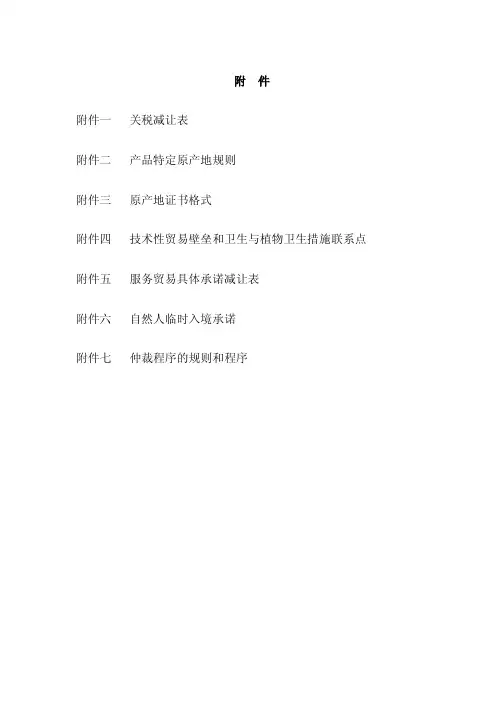
附件附件一关税减让表附件二产品特定原产地规则附件三原产地证书格式附件四技术性贸易壁垒和卫生与植物卫生措施联系点附件五服务贸易具体承诺减让表附件六自然人临时入境承诺附件七仲裁程序的规则和程序附件一关税减让表第一部分中方关税减让表一、本附件中的关税减让表包含以下各列:(一)“编码”:《2007版协调制度》中使用的编码;(二)“描述”:编码所指产品的描述。
二、降税应于本协定生效时及此后每年1月1日,按照减让表的规定实施。
第二部分新加坡关税减让表一、本附件中的关税减让表包含以下各列:(一)“编码”:《2007版协调制度》中使用的编码;(二)“描述”:编码所指产品的描述。
二、降税应于本协定生效时实施。
附件二产品特定原产地规则附件二产品特定原产地规则11双方同意力争在本协定规定的关税减免实施前完成产品特定原产地规则的谈判。
附件三原产地证书格式附件三原产地证书格式第一部分中方原产地证书格式背页说明第一栏:应填写中国出口商的法人全称、地址(包括国家)。
第二栏:应填写新加坡收货人的法人全称、地址(包括国家)。
第三栏:应填写运输方式、路线,并详细说明离港日期、运输工具的编号及卸货口岸。
第四栏:不论是否给予优惠关税待遇,进口方海关必须在相应栏目标注(√)。
第五栏:应填写项目号码。
第六栏:应填写唛头及包装号码。
第七栏:应详细列明包装数量及种类。
详细列明每种货物的商品描述,以便于海关关员查验时识别。
商品描述应与发票所述及《协调制度》的商品描述相符。
如果是散装货,应注明“散装”。
在商品描述末尾加上“***”(三颗星)或“\”(斜杠结束号)。
第七栏的每种货物应填写《协调制度》六位数编码。
第八栏:若货物符合原产地规则,出口商必须按照下列表格中规定的格式,在第八栏中标明其货物享受优惠关税待遇所依据的原产地标准:出口商申明其货物享受优惠关税待遇所依据的原产地填入第八栏标准(1)中国-新加坡自贸区原产地规则规定在出“P”口方完全获得的产品(2)区域价值成分≥40%的产品“RVC”(3)符合产品特定原产地规则的产品“PSR”第九栏:毛重应填写“千克”。
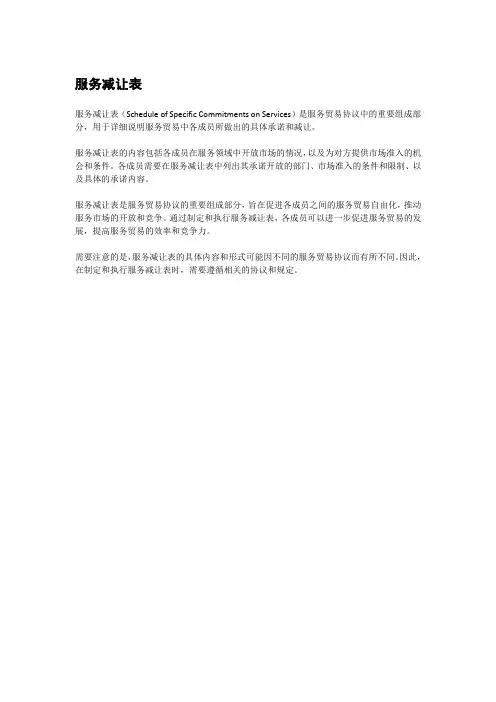
服务减让表
服务减让表(Schedule of Specific Commitments on Services)是服务贸易协议中的重要组成部分,用于详细说明服务贸易中各成员所做出的具体承诺和减让。
服务减让表的内容包括各成员在服务领域中开放市场的情况,以及为对方提供市场准入的机会和条件。
各成员需要在服务减让表中列出其承诺开放的部门、市场准入的条件和限制、以及具体的承诺内容。
服务减让表是服务贸易协议的重要组成部分,旨在促进各成员之间的服务贸易自由化,推动服务市场的开放和竞争。
通过制定和执行服务减让表,各成员可以进一步促进服务贸易的发展,提高服务贸易的效率和竞争力。
需要注意的是,服务减让表的具体内容和形式可能因不同的服务贸易协议而有所不同。
因此,在制定和执行服务减让表时,需要遵循相关的协议和规定。
经济师中级邮电经济专业知识与实务(邮政管制)模拟试卷1(题后含答案及解析)题型有:1. 单项选择题 2. 多项选择题单项选择题1.邮政管制的监督管理对象不包括( )。
A.邮政行业B.邮政企业C.邮政工作人员D.邮政市场正确答案:C解析:邮政管制是指邮政监管机构通过法律、行政和经济等手段,制定相应的政策、法规,对邮政行业、邮政企业、邮政市场实施监督、管理的行为。
知识模块:邮政管制2.( )是保护公民通信权的重要手段。
A.邮政成本核算B.邮政互联互通C.邮政全程全网D.邮政普遍服务正确答案:D 涉及知识点:邮政管制3.关于我国邮政体制改革的基本思路,下列说法不正确的是( )。
A.实行政企分开,加强政府监管,完善市场机制B.从机制和制度上保障特殊服务,确保通信安全C.改革通信网络和邮政储蓄管理体制D.促进邮政业向信息流、资金流和物流“三流合一”的现代邮政业方向发展正确答案:C解析:邮政体制改革的基本思路:是:实行政企分开,加强政府监管,完善市场机制,从机制和制度上保障普遍服务和特殊服务,确保通信安全;改革邮政主业和邮政储蓄管理体制,促进邮政业向信息流、资金流和物流“三流合一”的现代邮政业方向发展。
知识模块:邮政管制4.我国邮政机构的设立采取各省(区、市)设立邮政管理局,受国家邮政局垂直领导,负责省(区、市)邮政监管方式,这属于( )的设立方式。
A.自下而上B.自上而下和自下而上结合C.自上而下D.“遍地开花”正确答案:A 涉及知识点:邮政管制5.英国邮政管制机构是( )。
A.邮电部B.邮电监管局C.邮政用户理事会D.邮政行业监管委员会正确答案:D 涉及知识点:邮政管制6.政企分开后,国家邮政局独立行使监管职能,为了能够更加全面地履行监管职责,国家邮政局着力于构建( )的市场监管体系。
A.政府监管、行业自律、社会监督B.公众监管、行业自律、舆论监督C.司法监管、行业自律、社会监督D.政府监管、行业自律、舆论监督正确答案:A 涉及知识点:邮政管制7.受政府委托承担中国邮政普遍服务义务的是( )。
基金项目:教育部人文社会科学研究基金资助项目09YJ C820097)WT O 服务贸易承诺减让表之解释问题研究以 中美出版物和视听产品案 为例王 衡(西南政法大学国际法学院副教授、法学博士 重庆 401120)摘要:服务贸易承诺减让表的解释是WTO 服务贸易争端中的难点问题,也是 中美出版物和视听产品案 的重点问题。
目前,服务贸易承诺减让表的解释方法存在一定的缺陷。
WT O 争端解决机构在对服务贸易承诺减让表进行解释时,不仅应当考虑WTO 各成员服务贸易承诺减让表的特性,还应体现成员的公共政策考量,以促进WTO 法的健康发展。
服务贸易承诺减让表的解释问题不仅是WT O 成员在服务贸易争端个案中成败的关键,而且也给WT O 成员的国内立法、应诉策略提出了很高的要求,因此,WT O 成员在WTO 服务贸易谈判中应具有高度的前瞻意识。
关键词:WT O 法 服务贸易承诺减让表 条约解释 公共政策世界贸易组织(WTO)服务贸易承诺减让表(以下简称承诺表)是WT O 各成员服务业开放的重要法律文件。
从WTO 争端解决机构(DSB)的实践看,承诺表的解释是 安提瓜诉美国影响跨境提供赌博和博彩服务的措施案(以下简称 美国博彩案 )和 中国影响出版物和视听娱乐产品的贸易权和分销服务措施案 (以下简称 中美出版物和视听产品案 ) 等近期服务贸易争端案的主要争论点,直接影响到案件的结果。
美国博彩案 首次涉及承诺表的解释问题,并借鉴了关税减让表的解释经验。
美国博彩案 上诉机构认为,关税减让表不仅代表着对关税税率的约束,而且代表着WT O 成员的共同意图;与其他条约正文解释相似,关税减让表的 减让 含义之认定需依照 维也纳条约法公约 (以下简称 条约法公约 )第31条和第32条进行;承诺表是 服务贸易总协定 (GA TS)不可分割的组成部分,承诺表的解释与关税减让表的解释相似,需依照 条约法公约 第31条和第32条加以解释, 条约法公约 第31条和第32条构成承诺表解释的规则。
WTO基础知识复习题第一部分、单项选择题:1.中国正式成为WTO成员是在( 2001年12月11日 )。
2. 自1995年WTO成立以来,第三次部长级会议于1999年11月30日至12月3日在( 美国西雅图 )召开。
3.( 1993年12月15日 )在摩洛哥的马拉卡什召开的部长级会议上,“乌拉圭回合”谈判的各项议题的协议均获得通过,并采取”一揽子”方式接受。
4.提高生活水平,保证充分就业,大幅度稳步提高实际收入和扩大有效需求是世界贸易组织宗旨的第( 1 )条。
5.总理会指导下设三个专门理事会有货物贸易(服务贸易)和贸易有关的知识产权理事会的工作。
6.自由贸易原则主要体现为(关税减让)和禁止数量限制。
7.关贸总协定只处理(货物贸易 )问题.8.1997年2月15日,( 69)成员提交了55份关于基础电信的具体减让承诺表,构成了《基础电信协议》.9.从GATT到WTO多边贸易谈判的主题就是( 削减关税 ),逐步取消非关税壁垒措施.10. WTO组织规定,部长级会议设立专门委员会,负责处理( 3)各理事会的共同事物.11.常设上诉机构有7人组成,每一任期为4年,可以连任一次,其中的(3)人对有关案件的上诉进行审理。
12.接到磋商请求的争端方应自收到请求的(10)天内,对该请求做出答复。
13.原产地规定最早出现在(国内法中)中,在国际贸易实践中他常常被作为贸易保护主义的工具。
14.反不正当竞争一直是(知识产权)保护的一个重要方面.15.跨境提供或称跨境交付,指一个成员在其(境内)向任何其他成员境内提供服务.16.反倾销调查,是从一成员方反倾销主管当局根据(国内相关产业 )的申请开始的.17.1965年,《关税与贸易总协定》增补第(四)部分贸易和发展,鼓励发达国家支持发展中国家.18.”乌拉圭回合”谈判取得了成果,最后文件长达(450)页,涉及21领域,28个协议.19.从开始立案调查之日起到作出最终裁决通常为一年,特殊情况可以延长(60)天.20. WTO在日内瓦召开的中国工作组第16次会议上, WTO成员国与中国就所有遗留问题达成一致,这天是(2001年6月28日)。
20XX 标准合同模板范本PERSONAL RESUME甲方:XXX乙方:XXX服务贸易总协定2024版:跨境服务新趋势及合规要点本合同目录一览第一条定义与术语1.1 服务贸易总协定2024版1.2 跨境服务1.3 新趋势及合规要点第二条适用范围2.1 双方义务2.2 服务领域2.3 例外情况第三条原则与规则3.1 非歧视原则3.2 市场准入原则3.3 最惠国待遇原则3.4 透明度原则第四条服务贸易自由化4.1 跨境服务提供4.2 商业存在4.3 自然人存在4.4 跨境支付第五条服务贸易限制5.1 一般限制5.2 特定限制5.3 例外限制第六条服务贸易承诺表6.1 具体承诺6.2 修改与增减6.3 承诺的实施与监督第七条争端解决机制7.1 争端解决机构的设立与运作7.2 调解与仲裁7.3 强制性仲裁第八条国内法规的遵守8.1 国内法规的制定与实施8.2 法规的透明度8.3 法规的符合性评估第九条国际合作与协调9.1 双边与多边合作9.2 区域服务贸易安排9.3 国际组织参与第十条服务贸易促进措施10.1 信息服务与咨询10.2 能力建设与技术合作10.3 服务贸易便利化第十一条特定服务领域11.1 金融服务11.2 电信服务11.3 运输服务第十二条例外与保障措施12.1 一般例外12.2 特定例外12.3 保障措施第十三条条款的生效与执行13.1 合同的生效13.2 合同的执行与监督13.3 违约与责任第十四条条款的修订与终止14.1 条款的修订14.2 条款的终止14.3 终止后的权利与义务第一部分:合同如下:第一条定义与术语1.1 服务贸易总协定2024版1.2 跨境服务跨境服务是指一成员方的服务提供者在另一成员方境内提供服务的行为,包括但不限于跨境金融服务、电信服务、运输服务等服务。
1.3 新趋势及合规要点1.3.1 新趋势(a) 技术进步和数字化的推动下,跨境服务的形式和内容不断创新发展;(b) 服务贸易自由化和全球化进程加速,新兴市场和发展中国家的参与度逐渐提高;(c) 服务提供商和消费者对服务质量、效率和用户体验的要求不断提高。
附件9中华人民共和国服务贸易具体承诺减让表第2条最惠国豁免清单本减让表仅以英文为准服务提供方式:(1)跨境交付(2)境外消费(3)商业存在(4)自然人流动①依照中国法律、法规及其他措施订立的设立“契约式合资企业”的合同条款,规定诸如该合资企业经营方式和管理方式以及合资方的投资或其他参与方式等事项。
契约式合资企业的参与方式根据合资企业的合同决定,并不要求所有参与方均进行资金投入。
服务提供方式:(1)跨境交付(2)境外消费(3)商业存在(4)自然人流动服务提供方式:(1)跨境交付(2)境外消费(3)商业存在(4)自然人流动服务提供方式: (1)跨境交付 (2)境外消费(3)商业存在 (4)自然人流动服务提供方式:(1)跨境交付(2)境外消费(3)商业存在(4)自然人流动②高标准房地产项目指单位建设成本高出同一城市平均单位建设成本2倍的房地产项目。
服务提供方式:(1)跨境交付(2)境外消费(3)商业存在(4)自然人流动服务提供方式:(1)跨境交付(2)境外消费(3)商业存在(4)自然人流动③中国的承诺按照本减让表所附下列文件列入减让表:《关于编制基础电信服务承诺减让表的说明》(S /GBT/W/2/REV.1号文件)和《关于频率可获性的市场准入限制》(S/GBT/W/3号文件)。
所有国际通信服务应通过经中国电信主管机关批准设立的出入口局进行,中国电信主管机关将依照《参考文件》第5款的原则作为独立的监管机构运作。
本部门的进一步自由化,包括允许的资产参与水平,将在新一轮贸易谈判的服务贸易谈判中进行讨论。
服务提供方式:(1)跨境交付(2)境外消费(3)商业存在(4)自然人流动服务提供方式:(1)跨境交付(2)境外消费(3)商业存在(4)自然人流动④包括与基础设施建设有关的疏浚服务。
⑤ CPC 518的涵盖范围仅限于为外国建筑企业在其提供服务过程中所拥有和所使用的配有操作人员的建筑和/或拆除机器的租赁服务。
* 由于缺乏技术可行性,因此不作承诺。
W ORLD T RADE GATS/SC/90/Suppl.211April1997O RGANIZATION(97-1457)Trade in ServicesTHE UNITED STATES OF AMERICASchedule of Specific CommitmentsSupplement2(This is authentic in English only)_______________This text supplements the entries relating to the Telecommunications section contained on pages45to46of document GATS/SC/90.GATS/SC/90/Suppl.2Page 2U N I T E D S T A T E S -S C H E D U L E O F S P E C I F I C C O M M I T M E N T SM o d e s o f s u p p l y :1)C r o s s -b o r d e r s u p p l y2)C o n s u m p t i o n a b r o a d 3)C o m m e r c i a l p r e s e n c e 4)P r e s e n c e o f n a t u r a l p e r s o n sS e c t o r o r S u b -s e c t o r L i m i t a t i o n s o n M a r k e t A c c e s sL i m i t a t i o n s o n N a t i o n a l T r e a t m e n t A d d i t i o n a l C o m m i t m e n t s 2.C .T E L E C O M M U N I C A T I O N S S E R V I C E S *:2.C .a .V o i c e s e r v i c e s 2.C .b .P a c k e t -s w i t c h e d d a t a t r a n s m i s s i o n s e r v i c e s2.C .c .C i r c u i t -s w i t c h e d d a t a t r a n s m i s s i o n s e r v i c e s2.C .d .T e l e x s e r v i c e s2.C .e .T e l e g r a p h s e r v i c e s2.C .f .F a c s i m i l e s e r v i c e s 2.C .g .P r i v a t e l e a s e d c i r c u i t s e r v i c e s(1)N o n e(2)N o n e(3)N o n e ,o t h e r t h a n-C o m s a t h a s e x c l u s i v e r i g h t s t o l i n k s w i t h I n t e l s a t a n d I n m a r s a t .-O w n e r s h i p o f a c o m m o n c a r r i e r r a d i o l i c e n s e :I n d i r e c t :N o n eD i r e c t :M a y n o t b e g r a n t e d t o o r h e l d b y(a )f o r e i g n g o v e r n m e n t o r t h e r e p r e s e n t a t i v e t h e r e o f(b )n o n -U .S .c i t i z e n o r t h e r e p r e s e n t a t i v e o f a n y n o n -U .S .c i t i z e n(1)N o n e(2)N o n e (3)N o n e T h e U n i t e d S t a t e s u n d e r t a k e s t h e o b l i g a t i o n s c o n t a i n e d i n t h e r e f e r e n c e p a p e r a t t a c h e d h e r e t o .GATS/SC/90/Suppl.2Page 3M o d e s o f s u p p l y :1)C r o s s -b o r d e r s u p p l y 2)C o n s u m p t i o n a b r o a d 3)C o m m e r c i a l p r e s e n c e 4)P r e s e n c e o f n a t u r a l p e r s o n sS e c t o r o r S u b -s e c t o r L i m i t a t i o n s o n M a r k e t A c c e s sL i m i t a t i o n s o n N a t i o n a l T r e a t m e n t A d d i t i o n a l C o m m i t m e n t s2.C .o .O t h e rM o b i l e S e r v i c e sA n a l o g u e /D i g i t a l c e l l u l a r s e r v i c e sP C S (P e r s o n a l C o m m u n i c a t i o n s s e r v i c e s )P a g i n g s e r v i c e s M o b i l e d a t a s e r v i c e s*E x c l u d i n g o n e -w a y s a t e l l i t e t r a n s m i s s i o n s o f D T H a n d D B S t e l e v i s i o n s e r v i c e s a n d o f d i g i t a l a u d i o s e r v i c e s(c )a n y c o r p o r a t i o n n o t o r g a n i z e d u n d e r t h e l a w s o f t h e U n i t e d S t a t e s o r(d )U .S .c o r p o r a t i o n o f w h i c h m o r e t h a n 20%o f t h e c a p i t a l s t o c k i s o w n e d o r v o t e d b y a f o r e i g n g o v e r n m e n t o r i t s r e p r e s e n t a t i v e ,n o n -U .S .c i t i z e n s o r t h e i r r e p r e s e n t a t i v e s o r a c o r p o r a t i o n n o t o r g a n i z e d u n d e r t h e l a w s o f t h e U n i t e d S t a t e s .(4)U n b o u n d e x c e p t a s i n d i c a t e d b y h o r i z o n t a l c o m m i t m e n t s(4)U n b o u n d e x c e p t a s i n d i c a t e d b y h o r i z o n t a l c o m m i t m e n t s .GATS/SC/90/Suppl.2Page4ATTACHMENT TO THE UNITED STATES SCHEDULEREFERENCE PAPERScopeThe following are definitions and principles on the regulatory framework for the basic telecommunications services.DefinitionsUsers mean service consumers and service suppliers.Essential facilities mean facilities of a public telecommunications transport network or service that(a)are exclusively or predominantly provided by a single or limited number of suppliers;and(b)cannot feasibly be economically or technically substituted in order to provide a service.A major supplier is a supplier which has the ability to materially affect the terms of participation(having regard to price and supply)in the relevant market for basic telecommunications services as a result of:(a)control over essential facilities;or(b)use of its position in the market.petitive safeguards1.1Prevention of anti-competitive practices in telecommunicationsAppropriate measures shall be maintained for the purpose of preventing suppliers who,alone or together,are a major supplier from engaging in or continuing anti-competitive practices.1.2SafeguardsThe anti-competitive practices referred to above shall include in particular:(a)engaging in anti-competitive cross-subsidization;(b)using information obtained from competitors with anti-competitive results;and(c)not making available to other services suppliers on a timely basis technical informationabout essential facilities and commercially relevant information which are necessaryfor them to provide services.GATS/SC/90/Suppl.2Page52.Interconnection2.1This section applies to linking with suppliers providing public telecommunications transport networks or services in order to allow the users of one supplier to communicate with users of another supplier and to access services provided by another supplier,where specific commitments are undertaken.2.2Interconnection to be ensured1Interconnection with a major supplier will be ensured at any technically feasible point in the network.Such interconnection is provided.(a)under non-discriminatory terms,conditions(including technical standards andspecifications)and rates and of a quality no less favourable than that provided for itsown like services or for like services of non-affiliated service suppliers or for itssubsidiaries or other affiliates;(b)in a timely fashion,on terms,conditions(including technical standards andspecifications)and cost-oriented rates that are transparent,reasonable,having regardto economic feasibility,and sufficiently unbundled so that the supplier need not payfor network components or facilities that it does not require for the service to beprovided;and(c)upon request,at points in addition to the network termination points offered to themajority of users,subject to charges that reflect the cost of construction of necessaryadditional facilities.2.3Public availability of the procedures for interconnection negotiationsThe procedures applicable for interconnection to a major supplier will be made publicly available.2.4Transparency of interconnection arrangementsIt is ensured that a major supplier will make publicly available either its interconnection agreements or a reference interconnection offer.1Rural local exchange carriers may be exempted by a state regulatory authority for a limited period of time from the obligations of section2.2.with regard to interconnection with competing local exchange carriers.Rural telephone companies do not have to provide interconnection to competing local exchange carriers in the manner specified in section2.2.until ordered to do so by a state regulatory authority.GATS/SC/90/Suppl.2Page62.5Interconnection:dispute settlementA service supplier requesting interconnection with a major supplier will have recourse,either:(a)at any time or(b)after a reasonable period of time which has been made publicly knownto an independent domestic body,which may be a regulatory body as referred to in paragraph5below, to resolve disputes regarding appropriate terms,conditions and rates for interconnection within a reasonable period of time,to the extent that these have not been established previously.3.Universal serviceAny Member has the right to define the kind of universal service obligation it wishes to maintain. Such obligations will not be regarded as anti-competitive per se,provided they are administered in a transparent,non-discriminatory and competitively neutral manner and are not more burdensome than necessary for the kind of universal service defined by the Member.4.Public availability of licensing criteriaWhere a licence is required,the following will be made publicly available:(a)all the licensing criteria and the period of time normally required to reach a decisionconcerning an application for a licence and(b)the terms and conditions of individual licences.The reasons for the denial of a licence will be made known to the applicant upon request.5.Independent regulatorsThe regulatory body is separate from,and not accountable to,any supplier of basic telecommunications services.The decisions of and the procedures used by regulators shall be impartial with respect to all market participants.6.Allocation and use of scarce resourcesAny procedures for the allocation and use of scarce resources,including frequencies,numbers and rights of way,will be carried out in an objective,timely,transparent and non-discriminatory manner. The current state of allocated frequency bands will be made publicly available,but detailed identification of frequencies allocated for specific government uses is not required.。